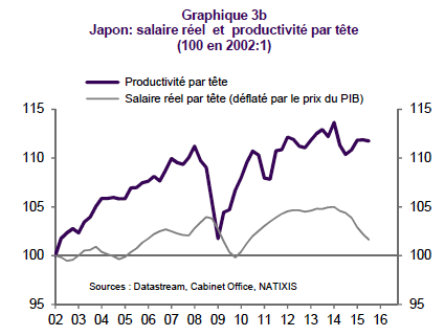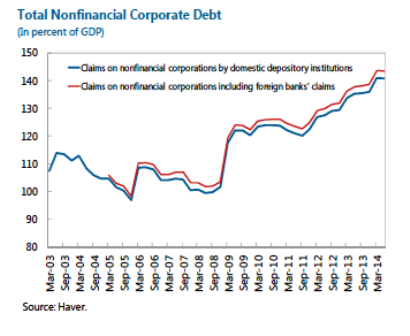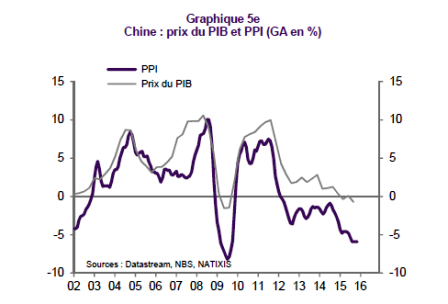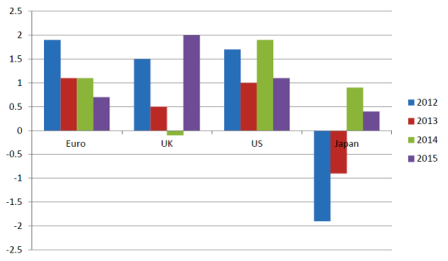TUAC NEWS
A message for the world’s leaders at Davos: Mind deflation, (re)build stronger collective bargaining systems
20/01/2016
- 1601t_IMF_WEFpdf
Download the report on the right-hand side
The IMF released its latest World Economic Outlook
(WEO) Update yesterday pointing to persistently weak growth and
another downward revision of its projected growth rates for 2016
and 2017 by 0.2 percentage points each year (
http://www.imf.org/external/pubs/ft/survey/so/2016/RES011916A.htm
). Despite this, the IMF’s growth trajectory still sees the world
economy recovering slightly from the weakness it experienced last
year (see Graph 1).
Graph 1: Outlook for world economic growth

Source: IMF World Economic Outlook Update (
http://www.imf.org/external/pubs/ft/weo/2015/update/02/pdf/0715.pdf
) and Natixis Flash Economie, 6/1/2016, nr. 20, (http://cib.natixis.com/flushdoc.aspx?id=88827
)
From past experience, however, we know that forecasters tend to
underestimate economic downturns while overestimating the recovery.
Given the vast list of negative shocks and developments that are or
will be hitting the economy, this time may NOT be different:
- In the US, the labour market is not in brilliant shape (unemployment numbers are low but the participation rate has fallen, there is no or little sign of accelerating wage dynamics either). At the same time, its economy is in its sixth year of economic expansion, a timing that is usually linked to the turning of the business cycle. The Fed’s decision to start raising interest rates in December 2015 would point in the same direction of a weakening business cycle (or rather one that is de facto being weakened because of monetary policy slowing it down).
- In the UK, growth over the recent years has been driven by household expenditure, which in turn was based on the reappearance of a certain real estate bubble. At this moment, however, household demand for new mortgages is decelerating. If the renewed real estate bubble would come to a standstill or go into reverse, UK growth performance would suffer.
- In Japan, while ‘Abenomics’ is injecting short bursts of demand and growth into the economy, it is failing to kick start the process by which growth becomes self-sustained as real wages in Japan keep lagging behind productivity (see Graph 2). Even if the government seems to have rediscovered the value of coordinated collective bargaining in steering the economy away from deflation and in redistributing high but idle corporate cash reserves back to workers, too many jobs in Japan remain precarious, part time and hence underpaid.
Graph 2: Evolution of real wages and productivity per head in Japan since 2002

Source: Natixis, Flash Economie, 06/01/2016
- Meanwhile, the Euro area keeps struggling with its own contradictions: The policy choice that Euro area policy makers made on replacing the missing instrument of currency devaluation by an internal devaluation of wages keeps feeding into disinflation. Combine this drive for downwards wage flexibility with other factors such as headline inflation already at zero due to falling oil prices, inflation expectations back on a downwards trend, record high levels of (public but also private!) debt loads, piles of non-performing loans in several parts of the euro area banking system and, last but not least, a Stability Pact or Fiscal Compact that keeps pushing several member states (notably Spain, France, Italy) into fiscal austerity, it becomes clear that the world economy cannot count on the Euro area economy to drive world economic growth. The opposite is the case: With a current account surplus approaching a level of 3.7% GDP, the Euro Area is subtracting even more demand and growth from the world economy than before (and more demand than China or Japan, recording a current account surplus of 3% and 3.3% respectively).
- In the emerging part of the world, China is caught in the same
trap of capitalist exuberance, over-indebtedness and
over-investment that other economies have come to know so very
well. As can be seen from the graphs below, since 2008, corporate
(non-financial) sector debt has gone into overdrive, increasing
from around 100% to almost 150% of GDP.
Graph 3: Nonfinancial Corporate Debt in China

Source: IMF, Assessing China’s corporate sector vulnerabilities, WP
15/72, (https://www.imf.org/external/pubs/ft/wp/2015/wp1572.pdf
)
Sooner or later, however, over-investment results in overcapacity,
translating into downwards pressure on prices: Indeed, producer
prices in China (see PPI line in Graph 4) are now falling at a pace
of 5%. In addition to this, the exchange rate of the Chinese
currency is also coming under pressure so that the problem of
producer price deflation is not just limited to China but is also
exported to the rest of the world.
Graph 4: GDP deflator and Producer Price Index in China

Source: Natixis. Flash Economie, 06/01/2016
- The other big emerging economies (such as Brazil, South Africa) constitute the next domino. Their exports come under pressure as a result of weakening import demand from China for their commodities or from the competitive weakening of the Chinese currency. And, while the financial market turmoil that accompanies this will push the exchange rate of these economies further down, it will also result in higher interest rates (monetary policy becoming restrictive in an attempt to keep financial capital inside the country so as to limit the downfall of the currency), which will then stifle overall economic growth.
Two reflections going forward
1. The IMF itself, at least
implicitly, recognizes part of the concerns mentioned above as it
writes that risks are ‘tilted to the downside’. The IMF in
particular identifies these as ‘a generalised slowdown in emerging
markets, China’s rebalancing, lower commodity prices, and the
gradual exit from extraordinarily accommodative monetary conditions
in the US”.
2.
While at Davos, the world government and business leaders will
discuss the ‘future of work’- it is also important to look at the
‘present state of work’. Judging from the above, one cannot ignore
that the world economy is heading for another cycle of weakening
growth and this, at the very moment, when price and inflationary
pressures are already at too low levels. If, as it has been the
case in the past, this new slowdown would trigger a further
deceleration of inflation dynamics, too low inflation will become
outright deflation with all of its dire consequences on the economy
(rising real interest rates, increased real burden of debt, falling
aggregate demand, and ultimately, even more intense
deflation). In that case, policy makers would do well to consider
that strong and robust systems of collective bargaining do not only
tend to control for rising inequalities (as evidenced by a recent
IMF report https://www.imf.org/external/pubs/ft/sdn/2015/sdn1514.pdf
) but that, by keeping the level and dynamics of nominal wages up,
they can also play a key role in breaking the vicious circle
whereby falling prices and falling wages are chasing each
other.
To illustrate the latter, consider Graph 5 showing that unit labour
cost dynamics have become particularly compressed and, especially
so in the case of Japan and the Euro Area, are way out of line with
minimal inflation targets of 2 or between 2 and 3%. The conclusion
to draw is straightforward: If central bankers want to steer the
economy away from the edge of deflation and revive modest inflation
rates, they would do well to start considering strong and
coordinated systems of collective bargaining as a way to uphold
price stability and re-anchor inflation expectations.
Graph 5: Nominal unit wage costs, annual percentage increase

Source: European Commission, 2015